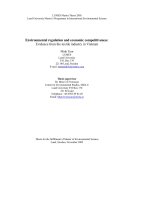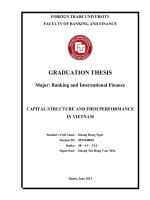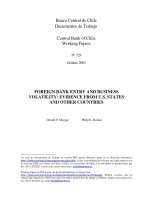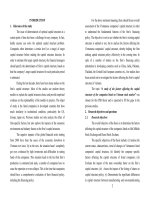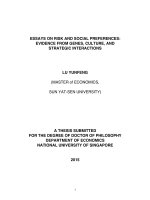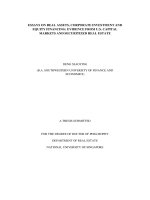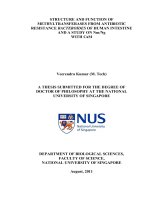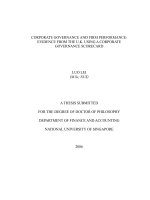Capital structure and growth option evidence from vietnams stock market
Bạn đang xem bản rút gọn của tài liệu. Xem và tải ngay bản đầy đủ của tài liệu tại đây (1.97 MB, 130 trang )
SCHOOL OF ECONOMICS
INSTITUTE OF SOCIAL STUDIES
UNIVERSITY OF ECONOMICS
ERASMUS UNIVERSITY ROTTERDAM
HO CHI MINH CITY
THE HAGUE
VIETNAM
THE NETHERLAND
VIETNAM - THE NETHERLANDS PROGRAMME FOR M.A.
IN DEVELOPMENT ECONOMICS
CAPITAL STRUCTURE AND GROWTH OPTION:
EVIDENCE FROM VIETNAM’S STOCK MARKET
by Nguyen Cong Thanh
A thesis submitted in partial fulfilment of the requirements for
the degree of
Master of Art in
Development Economics
Ho Chi Minh city, October 2017
VIETNAM - THE NETHERLANDS PROGRAMME FOR M.A. IN
DEVELOPMENT ECONOMICS
CAPITAL STRUCTURE AND GROWTH OPTION:
EVIDENCE FROM VIETNAM’S STOCK MARKET
by Nguyen Cong Thanh
A thesis submitted in partial fulfilment of the requirements for
the degree of
Master of Art in
Development Economics
Academic Supervisor:
Dr. Nguyen Vu Hong Thai
Ho Chi Minh city, October 2017
DECLARATION
I hereby declare that my dissertation entitled “Capital Structure and Growth
Option: Evidence from an Emerging Market” is the result of my own work and includes
nothing which is the outcome of work done in collaboration except as declared in the
Preface and specified in the text.
My dissertation is not substantially the same as any that I have submitted, or, is
being concurrently submitted for a degree or diploma or other qualification in any other
University or similar institution except as declared in the Preface and specified in the
text.
I further state that no substantial part of my dissertation has already been
submitted, or, is being concurrently submitted for any such degree, diploma or other
qualification at any other University or similar institution except as declared in the
Preface and specified in the text.
Date: October 10th, 2017
Signature .....................................................
Full name: Nguyen Cong Thanh
ACKNOWLEDGEMENT
A successful thesis cannot be fulfilled without the unrelenting support of my
dedicated supervisor, Dr. Nguyen Vu Hong Thai, who has devoted all of his time,
efforts, and energy to guiding me during the course of doing the thesis. His dedication
is what makes me feel impressive when I have a chance to work with him, his
friendliness is what makes me feel comfortable when I ask him some difficult questions,
and his enthusiasm is what makes me feel energetic when I have difficulty in solving a
problem in my research. All of these leave me with the most unforgettable memory and
experience. My purpose of this acknowledgement is to express my inexpressible
gratitude to my dear supervisor. There is a good teacher, there is an excellent student.
I would like to send my special thanks to Prof. Nguyen Trong Hoai, Dr. Pham
Khanh Nam, Dr. Truong Dang Thuy for their valuable command, guidance and support
during the program. Furthermore, I am extremely grateful to give Dr. Nguyen Phuc
Canh and Dr. Tran Thi Tuan Anh all my best thanks from bottom of my heart for
everything they have done to support me.
Besides, my thanks are given to all of the lectures who have been my knowledge
guiders and the staff who have been my service supporters throughout the master
program at University of Economics and Erasmus University Rotterdam. Without their
help, never can I have an opportunity to proceed and complete my master thesis.
The last but not least, I would like to thank Dr. Tran Gia Tung, Pham Thi Anh Thu
and Tran Le Khang who have always been a pillar for me to rely on during the hardships
of attempting to achieve the master thesis. It is their unspoken sacrifice and untiring
work that bring me more spare time to be able to reach the final destination of my
progress.
ABSTRACT
The research identifies the impacts of growth opportunities on capital structure of
Vietnamese companies. All of the listed firms on Ho Chi Minh Stock Exchange (HOSE)
and Hanoi Stock Exchange (HNX) from 2008 to 2015 are included in the research data.
The regression methods for panel data including Pooled Ordinary Least Squared
(POLS), Fixed Effects Models (FEM), Random Effects Models (REM), and System
Generalized Method of Moments (SGMM) are used for the whole sample and two
subsamples for the years after and during the financial crisis. The results indicate that
growth opportunities have significantly positive effects on leverage measured by both
short-term and long-term debt over total assets. Interestingly, the sign of this
relationship remains unchanged in the pre-crisis and post-crisis. In addition, this finding
proves the existence of Pecking Order Theory in Vietnamese firms’ capital structure
during this period because Vietnam has more financial constraints in getting the bank
loans during the crisis, its legal systems are strictly controlled by the government or by
state-owned enterprises, its law codes are too weak to protect the rights of shareholders
and bondholders, and most of its firms are virtually comprised of small and medium
enterprises.
Keywords: capital structure, growth option, emerging markets, pecking order
theory, trade-off theory.
JEL classifications: G31, G34.
TABLE OF CONTENTS
CHAPTER 1: INTRODUCTION ........................................................................... 1
1.1.
Problem Statement and Significance of research .......................................... 1
1.2.
The Research Objectives and Research Questions ....................................... 3
1.3.
Structure of Thesis Design ............................................................................ 3
CHAPTER 2: RELATED THEORIES AND LITTERATURE REVIEW ........ 4
2.1.
Overview of the related theories ................................................................... 4
2.1.1.
Theory of irrelevancy .................................................................................... 5
2.1.2.
Trade – off theory .......................................................................................... 7
2.1.2.1. Static trade-off theory .................................................................................... 7
2.1.2.2. Dynamic Trade-off Theory ........................................................................... 8
2.1.3.
Pecking order theory ................................................................................... 10
2.1.4.
The market timing theory ............................................................................ 13
2.1.5.
Theory of agency costs ................................................................................ 14
2.2.
Literature Review ........................................................................................ 15
2.2.1.
Some previous review on trade-off theory and pecking order theory ......... 15
2.2.2.
Some previous studies on growth options and firm leverage ...................... 17
2.2.3.
Some related literature in Vietnam .............................................................. 26
CHAPTER 3: METHODOLOGY AND DATA .................................................. 30
3.1.
Research Methodology ................................................................................ 30
3.2.
Research Data .............................................................................................. 32
CHAPTER 4: RESULTS AND DISCUSSIONS .................................................. 35
CHAPTER 5: CONCLUSIONS ............................................................................ 46
5.1.
Remarkable conclusions .............................................................................. 30
5.2.
Limitation and further research ................................................................... 32
REFERENCES ....................................................................................................... 47
Appendix 1. Table 4 Column 1 result................................................................................... 53
Appendix 2. Table 4 Column 2 result................................................................................... 53
Appendix 3. Table 4 Column 3 result................................................................................... 54
Appendix 4. Table 4 Column 4 result................................................................................... 54
Appendix 5. Table 4 Column 5 result................................................................................... 55
Appendix 6. Table 4 Column 6 result................................................................................... 55
Appendix 7. Table 5 Column 1 result................................................................................... 56
Appendix 8. Table 5 Column 2 result................................................................................... 56
Appendix 8. Table 5 Column 3 result................................................................................... 57
Appendix 10. Table 5 Column 4 result................................................................................. 57
Appendix 11. Table 5 Column 5 result................................................................................. 58
Appendix 12. Table 5 Column 6 result................................................................................. 58
Appendix 13. Table 6 Column 1 result................................................................................. 59
Appendix 14. Table 6 Column 2 result................................................................................. 59
Appendix 15. Table 6 Column 3 result................................................................................. 60
Appendix 16. Table 6 Column 4 result................................................................................. 60
Appendix 17. Table 6 Column 5 result................................................................................. 61
Appendix 18. Table 6 Column 6 result................................................................................. 61
Appendix 19. Table 7 Column 1 result................................................................................. 62
Appendix 20. Table 7 Column 2 result................................................................................. 62
Appendix 21. Table 7 Column 3 result................................................................................. 63
Appendix 22. Table 7 Column 4 result................................................................................. 63
Appendix 23. Table 7 Column 5 result................................................................................. 64
Appendix 24. Table 7 Column 6 result................................................................................. 64
Appendix 25. Table 8 Column 1 result................................................................................. 65
Appendix 26. Table 8 Column 2 result................................................................................. 65
Appendix 27. Table 8 Column 3 result................................................................................. 66
Appendix 27. Table 8 Column 4 result................................................................................. 66
Appendix 29. Table 8 Column 5 result................................................................................. 67
Appendix 30. Table 8 Column 6 result................................................................................. 67
Appendix 31. Table 9 Column 1 result................................................................................. 68
Appendix 32. Table 9 Column 2 result................................................................................. 68
Appendix 33. Table 9 Column 3 result................................................................................. 69
Appendix 34. Table 9 Column 4 result................................................................................. 69
Appendix 35. Table 9 Column 5 result................................................................................. 70
Appendix 36. Table 9 Column 6 result................................................................................. 70
Appendix 37. Table 10 Column 1 result............................................................................... 71
Appendix 38. Table 10 Column 2 result............................................................................... 71
Appendix 39. Table 10 Column 3 result............................................................................... 72
Appendix 40. Table 10 Column 4 result............................................................................... 72
Appendix 41. Table 10 Column 5 result............................................................................... 73
Appendix 42. Table 10 Column 6 result............................................................................... 73
Appendix 43. Table 11 Column 1 result............................................................................... 74
Appendix 44. Table 11 Column 2 result............................................................................... 74
Appendix 45. Table 11 Column 3 result............................................................................... 75
Appendix 46. Table 11 Column 4 result............................................................................... 75
Appendix 47. Table 11 Column 5 result............................................................................... 76
Appendix 48. Table 11 Column 6 result............................................................................... 76
Appendix 49. Table 12 Column 1 result............................................................................... 77
Appendix 50. Table 12 Column 2 result............................................................................... 77
Appendix 52. Table 12 Column 3 result............................................................................... 78
Appendix 53. Table 12 Column 4 result............................................................................... 78
Appendix 54. Table 12 Column 5 result............................................................................... 79
Appendix 55. Table 12 Column 6 result............................................................................... 79
Appendix 56. Table 14 Column 1 result............................................................................... 88
Appendix 57. Table 14 Column 2 result............................................................................... 90
Appendix 58. Table 14 Column 3 result............................................................................... 92
Appendix 59. Table 14 Column 4 result............................................................................... 94
Appendix 60. Table 14 Column 5 result............................................................................... 96
Appendix 61. Table 14 Column 6 result............................................................................... 98
Appendix 62. Table 15 Column 1 result............................................................................. 100
Appendix 63. Table 15 Column 2 result............................................................................. 101
Appendix 64. Table 15 Column 3 result............................................................................. 102
Appendix 65. Table 15 Column 4 result............................................................................. 103
Appendix 66. Table 15 Column 5 result............................................................................. 104
Appendix 67. Table 15 Column 6 result............................................................................. 106
Appendix 68. Table 16 Column 1 result............................................................................. 108
Appendix 69. Table 16 Column 2 result............................................................................. 110
Appendix 70. Table 16 Column 3 result............................................................................. 112
Appendix 71. Table 16 Column 4 result............................................................................. 114
Appendix 72. Table 16 Column 5 result............................................................................. 115
Appendix 73. Table 16 Column 6 result............................................................................. 116
LIST OF TABLES
Table 1. Control variables definition ....................................................................... 31
Table 2. Descriptive Statistics ................................................................................. 33
Table 3. Correlation Matrix ..................................................................................... 34
Table 4. Estimated results using POLS with Total Debt to Total Asset represented
for Leverage .............................................................................................................. 35
Table 5. Estimated results using POLS with Short-term Debt to Total Asset
represented for Leverage .......................................................................................... 36
Table 6. Estimated results using POLS with Long-term Debt to Total Asset
represented for Leverage .......................................................................................... 37
Table 7. Estimated results using FEM with Total Debt to Total Asset represented for
Leverage ................................................................................................................... 38
Table 8. Estimated results using FEM with Short-term Debt to Total Asset
represented for Leverage .......................................................................................... 39
Table 9. Estimated results using FEM with Long-term Debt to Total Asset
represented for Leverage .......................................................................................... 40
Table 10. Estimated results using REM with Total Debt to Total Asset represented
for Leverage .............................................................................................................. 41
Table 11. Estimated results using REM with Short-term Debt to Total Asset
represented for Leverage .......................................................................................... 42
Table 12. Estimated results using FEM with Long-term Debt to Total Asset
represented for Leverage .......................................................................................... 43
Table 13. Parameters Test, Hausman Test and Breusch & Pagan Lagrange multiplier
Test. .......................................................................................................................... 44
Table 14. Estimated results using SGMM with Total Debt to Total Asset represented
for Leverage .............................................................................................................. 46
Table 15. Estimated results using SGMM with Short-term Debt to Total Asset
represented for Leverage .......................................................................................... 48
Table 16. Estimated results using SGMM with Long-term Debt to Total Asset
represented for Leverage .......................................................................................... 50
ABBREVIATIONS
HNX:
Hanoi Stock Exchange
HOSE:
Ho Chi Minh Stock Exchange
POLS:
Pooled Ordinary Least Squared
FEM:
Fixed Effects Model
REM:
Random Effects Model
SGMM:
System Generalized Method of Moments
CHAPTER 1: INTRODUCTION
1.1.
Significance of research
The relationship between capital structure and growth options is explained in two
main theories including pecking–order theory and trade–off theory in the financial
literature. Specifically, an immense of studies have been done in order to examine the
aforementioned relationship in the economic field of finance and capital analysis
following these theories (for instance, see Adedeji (2002), Antoniou et al. (2008),
Antoniou et al. (2008)). Actually, these empirical justify the capital structure and growth
options under the light of trade–off theory and pecking–order theory have been taken in
the context of developed countries such as US, Japan, UK, which have strong market
disciplines, corporate governance and less agency problems (Harford et al., 2012).
Some recent studies consider these theories in the context of emerging countries
such as China with the results favoring the existence of pecking – order theory. For
example, Chen (2004) discovers there has no persuadable explanation for the capital
choices of the Chinese firms from the pecking-order and the trade-off model hypothesis
derived from the Western. Obviously, the capital choice decision of Chinese enterprises
is predictably followed a “new pecking-order” that includes long-term debt, retained
earnings and equity. One explanation is that China cannot access easily foundational
assumptions supporting the Western countries. Besides, negative correlations between
profitability and leverage is found to be significant by Tong and Green (2005).
Meanwhile, positive correlation is found to be significant between current leverage and
past dividends as well as supports the pecking-order hypothesis over trade-off theory in
Chinese companies. Yao-hui and Yuan-lue (2007) employ independent variables which
are arranged properties of ordered probit model, so once again the pecking-order theory
is appeared to be presented in Chinese companies. Additionally, Ni and Yu (2008)
examine if the financial structure of Chinese companies follows a pecking-order that is
from debt to equity; especially, when they rise funds to invest firms’ projects, they find
no evidence related to Chinese companies follow a pecking-order. Importantly, they
indicate that big companies follow a pecking-order whilst small and medium ones do
1
not that lead to suggestion that the Chinese capital market is under development
precisely.
Moreover, the turbulences of the 2008 global financial crisis have revised the
attention to the relationships between growth options and financial leverages in
emerging markets, especially in a small one such as Vietnam, which is suffered from a
hardship period from 2008 to 2012 with many cases of firm’s bankruptcy and problem
in banking system (Vo and Nguyen, 2014). In addition, the stock market of Vietnam
has been developed from the beginning of 2000 (Vo and Nguyen, 2016), which creates
new channel for Vietnamese firms in choosing funds for their projects besides the loans
from commercial banks as the traditional way, as a consequence, the behaviors of
Vietnamese firms may be impacted. Therefore, this study fills the gap of financial
literature by clarifying the relationship between growth options and financial structure
of Vietnamese firms during the period of 2008 – 2015.
In summary, this study will examine the impacts of growth option on capital
structure of Vietnamese firms during the period of 2008 – 2015 with many sophisticated
problems in Vietnam. First of all, the period of 2008 – 2015 sees the high turbulences
in Vietnamese banking system with the problem of bad debt and other problems. This
fact creates more financial constraints for Vietnamese firms in getting bank loans.
Secondly, the wide disparity between governing firms' operations and legal systems
specially the intervention of Vietnamese government and the presence of government
in the economy through the state-owned enterprises. Next, the Vietnam law system is
still weak to protect the rights of shareholders and also bondholders which creates the
asymmetric information problem. Finally, almost the Vietnamese firms are still in small
and medium sizes according to the world’s standardized view. The most important
feature is the low development of equity market and especially bond markets which
limits the options of firm managers in managing their capital structure. Therefore, this
study states that the significant low development of equity and bond markets, the
presence of asymmetrical information, the financial constraints from getting bank loans
and these mentioned problems in Vietnam are the conditions for the presence of the
pecking–order theory when explaining the capital structure of Vietnamese firms. In
addition, after 4 years from the beginning of the global financial crisis in 2008, the
2
Vietnamese economy has a sign of the recovery in corporate sector, banking sector, and
the overall economy. Hence, the relationship between growth options and the capital
structure may be influenced.
1.2.
The Research Objectives
Motivation
First, the period of 2008 – 2015 sees the high turbulences in Vietnamese banking
system with the problem of bad debt and other problems.
Second, the wide disparity between governing firms' operations and legal systems
specially the intervention of Vietnamese government and the presence of government
in the economy through the state-owned enterprises.
Third, the Vietnam law system is still weak to protect the rights of shareholders
and also bondholders which creates the asymmetric information problem.
The most important feature is the low development of equity market and especially
bond markets which limits the options of firm managers in managing their capital
structure.
=> These mentioned problems in Vietnam are the conditions for the presence of
the pecking–order theory when explaining the capital structure of Vietnamese firms. In
this case, it is the pecking order theory that can lead to the positive relationship between
growth option and leverage; therefore, the study identifies whether this relationship is
true for the case of companies in Vietnam. It is the underlying motivation for this study.
Research questions
The motivation helps me figure out problem statement and research questions for
this thesis. My problem statement is that this study examines the effect of growth option
on capital structure in order to clarify whether the pecking–order theory exists due to
the presence of asymmetric information, the low development of equity and bond
market and some financial constraints in Vietnam market in the period of 2008 – 2015.
And base on this problem statement I come out with three research questions:
3
Is the relationship between growth opportunities and capital structure
positive?
Is the impact of growth option on capital structure linear or non-linear for
Vietnamese firms?
Is this effect different in the two period during and after the financial crisis?
1.3.
Structure of Thesis Design
This study firstly estimates the relationship between growth options and financial
leverages of Vietnamese firms, then I divide the data into two sub-periods: the period
from 2008 to 2011 which presents for the period of crisis, and the period from 2012 to
2015 which presents for the period of post – crisis. The rest of this study is organized
as following manners. Chapter 2 presents some related theories and previous literature
review on the relationship between growth options and financial leverage following the
pecking – order and trade – off theory. Chapter 3 presents the data and methodology.
Chapter 4 shows the estimation results and discussions. The final chapter gives some
remarkable conclusions and discuss limitation of the study.
4
CHAPTER 2: RELATED THEORIES AND LITTERATURE REVIEW
2.1.
Overview of the related theories
Since the introduction of the Modigliani and Miller's “Irrelevance Hypothesis”,
capital structure has gained its popularity in analysis (Modigliani and Miller, 1958).
Based on this work, Damodaran (1999) refers capital structure as the proportion
distributed between the shares of assets processed by inside and outside investors.
Thanks to the research on the cost of capital, funds of partnerships, and investment,
capital structure stands still for a very long time (Ibrahimo and Barros, 2009). Moreover,
the fundamental masterpiece of Modigliani and Miller (1958) shows that when the
economic situations are immaculate and rearranged, the creators infer that capital
structure is insignificant to the assurance of the partnership esteem, from which a new
skyline of hypothesis has been created and incorporated thoughts of genuine economic
situations and the operators of conducts (Kayo and Kimura, 2011, Bastos et al., 2009).
Along the way of development arose three noteworthy categories of capital
structure’s theories which veer from the presumption of faultless capital markets to the
approach of an imperfect ones. First is Trade-off Theory, which indicates the exchange
between the benefits and costs of obligations on the firms’ financing to optimize capital
structure in the presence of defects in the business sector such as taxes, insolvency
expenses, and floatation costs. Second is Pecking-order Theory given by Myers (1984),
which suggests the financing hierarchy of an organization in order to limit the issue of
information asymmetry between inside managers and outside shareholders. Third is
Market Timing Theory proposed by Baker and Wurgler (2002), which expresses the
formation of the capital structure as the past endeavors of firms to time the market. This
theory holds that companies will issue new shares to the market when they find that the
market price for their shares are overpriced and repurchase its shares when they consider
that their shares are underpriced. Although the interest in Market Timing Theory has
been settled down, this theory still demonstrates that the impact of market timing on
capital structure is exceptionally distinguished.
5
There is some previous empirical research of joins the approaches of the three
capital structure theories.
The decisions on the capital structure at the cross-section level.
The determinants of the capital structure over time.
The studies investigating the consequences of indebtedness at the
corporation’s scope (Parsons and Titman, 2009).
The polarization on the conventional points of view between Trade-off Theory
and Pecking-order Theory has paved the way for the development in the methodology
of the capital structure through utilized factors, analyzing models, and inspecting
qualities (Graham and Leary, 2011).
The disagreement among these hypotheses in the field of corporate finance gives
an opportunity for researchers around the world to synthetize literature reviews and
extend the examinations. Lately, endeavors in writing about capital structure were
attempted, in which the explorations by Tudose (2012), Graham and Leary (2011) as
well as Parsons and Titman (2009) were highlighted. After the presuppositions of
Modigliani and Miller (1958), the theories that energize the examination with respect
to the decisive components of corporate capital structure were Pecking-order Theory
and the Trade-off Theory (Myers, 1984, Graham and Leary, 2011), These speculations
bring the development of other critical components to the examination of financing in
an organization:
The influence of income tax in financial expenses (Myers and Turnbull,
1977, Myers, 1977)
The cost of bankruptcy (Titman, 1984)
Agency costs (Jensen and Meckling, 1976)
Asymmetric information (Stulz, 1990)
The firm’s prioritization on the source of funds (Myers and Majluf,
1984).
6
2.1.1. Theory of irrelevancy
Irrelevance Capital Structure Theory, introduced by Modigliani and Miller (1958)
(M&M theory), is viewed as the development of capital structure (Damodaran, 2002,
Graham and Harvey, 2001, Feld et al., 2013).
The creative point of view of the creators restricted customary that expected an
incredible significance to financing as indicated by the distinctions in variety of cost of
value and diverse levels of obligations (Myers and Turnbull, 1977, Myers, 1977). The
formalization of the traditional thinking before M&M can be proved by the work of
Durand (1952) that creators are viewed as a pioneer in the investigations of capital
structure (Santosa and de Moraes Farinellib, 2015).
The suggestions of M&M were dissected. First is the consideration of a monetary
situation without tax assessment on income and with full market effectiveness (Kayo
and Kimura, 2011). Thoughts under these suggestions prompted to the conclusion that
the estimations of an enterprise cannot be related to the costs of obligations, especially,
obligation approaches (Ibrahimo and Barros, 2009).
Therefore, the estimations of an association ought to speak to the estimations of
its benefits by ascertaining the estimations of free money streams in a manner that the
increments in obligations do not have an impact on weighted marginal cost of capital
(Damodaran, 2002). Keeping in mind that the lasting goal is to bolster the preface of
insignificance. M&M exhibited that the obligation costs will not differ in the view of
the measurement. However, if it happens by chance, there would be a plausibility from
outer gatherings. By the way, the costs of value would have a positive and direct
connection with the level of obligations. Thus, in the view of budgetary hazard,
accepting an outsider in order to raise equity has a cost of capital lower than the value
of the capital, and this would bring about a higher net value (Modigliani and Miller,
1958).
After assessing the model, M&M presented another paper in 1963 perceiving the
significance of the deductibility of money related costs in the computation of wage
assessment (Modigliani and Miller, 1963). Be that as it may, the premises related to the
ideal market and the objectivity of specialists were condemned in the earlier decades,
7
and they brought in the development of Trade-off Theory and Pecking-order Theory
(Ibrahimo and Barros, 2009).
2.1.2. Trade – off theory
The term trade-off theory is employed by various researchers to portray a group
of related theories. In this hypothesis, a manager managing a firm identify the different
costs and benefits of arranged options. Frequently, an inside preparation is expected to
be acquired so that minimal expenses and negligible advantages are adjusted. The first
form of the trade - off theory became out of the open deliberation over the ModiglianiMiller hypothesis. At the point, when corporate salary duty comes to an excess, this
made an advantage of obligations in that it served to avoid expenses. Since the
company's target is straight and there is no optimal expense of obligations, this inferred
100% obligations for financing.
Initially, the objective is not specifically discernible, but it might be credited from
confirmation. Therefore, diverse papers include the structure in various ways (Campbell
and Kelly, 1994, Hackbarth et al., 2007, Ju et al., 2005, López-Gracia and Sogorb-Mira,
2008, Hovakimian et al., 2011). Second, the obligation is considerably more intricate
than what is expected by the hypothesis. Contingents, upon which components of the
expense code, are incorporated, and diverse conclusions with respect to the objective
can be instilled. Graham (2003) gives a helpful survey of the writing on the assessment
of the impacts. Third, insolvency costs must be incurred instead of exchanges starting
with one obligation requirement and then the next one. The way of these expenses is
essential as well. Haugen and Senbet (1978) give a valuable discourse of insolvency
costs. Fourth, exchange costs must take a particular shape for the examination to work.
For the conformity, to be as slow as opposed to what is unexpected, the peripheral costs
of alteration increase when the alteration is bigger. Leary and Roberts (2005) portray
the ramifications of options of alteration cost suspicions.
2.1.2.1.
Static trade-off theory
The static trade – off theory states that firms have an optimal capital structure,
which they can figure out by trading off the costs against the benefits of obligations and
value. One of the advantages is the upside of an obligation for tax shield. One of the
8
disservices of obligations is the cost of potential money-related trouble, particularly
when the firm depends on an excessive number of obligations. As of now, this prompts
to a trade – off between the tax break and the detriment of higher danger of moneyrelated trouble. Be that as it may, there are more costs and advantages required together
with the utilization of obligations and value. Another real cost comprises of
organizational expenses. Organizational costs originate from the irreconcilable
circumstances between the diverse partners of the firm and due to asymmetric
information (Jensen and Meckling, 1976, Jensen, 1986). Hence, integrating
organization costs into the static trade – off theory implies that a firm decides its capital
structure by trading off the expense preferred standpoint of obligations against the
expenses of budgetary pain of a lot of obligations and the office expenses of obligations
against the office costs of value. Numerous cost components have been recommended
under the trade – off theory, and the theory would prompt far to examine them all. As a
result, this examination is in line with the confirmation that a vital expectation of the
static trade – off theory is that organizations pay attention to their capital structures. For
instance, in case that the real proportion strays from the one considered ideal, the firm
will regulate its financing practice to reach the ideal capital structure.
2.1.2.2.
Dynamic Trade-off Theory
Dynamic models perceive that time determines various perspectives that are
normally disregarded in a single-period model. Out of the specific significance are the
desires and alteration costs. In a dynamic model, the appropriate financial choice relies
on the financing margins that the firm is still doubtable in the following timeframe.
Some companies desire to pay out funds in the following timeframe, while others hope
to raise funds. On the off chance that assets are to be raised, they may appear as
obligations or value. By and large, a firm embraces a blend of these activities. An
essential forerunner to modern dynamic trade-off theories was Stiglitz (1973), who
looks at the impacts of the assessment of tax from an open fund.
The very first dynamic trade – off model considering the tax savings in comparison
with insolvency costs was built by Kane et al. (1985) & Brennan and Schwartz (1984).
Both broke down constant time models with instability, taxes, and insolvency costs but
no exchange costs. Since firms respond to unfriendly stuns quickly by re-adjusting cost9
less, firms keep up abnormal amounts of obligations to exploit the tax advantages.
Dynamic trade-off models can likewise be utilized to consider the alternative aspects
instilled in conceding choices to the following timeframe. Goldstein et al. (2001) show
that firms with low leverage today have the resulting alternative to expand the leverage.
Under their presumptions, the alternative to build up the rate of leverage that then is
served to lessen the generally ideal level of leverage at present.
Strebulaev (2007) investigated a similar model to Fischer et al. (1989) and
Goldstein et al. (2001). Additionally, if firms are held back intermittently due to the
transaction costs, then almost all firms with obligations will veer off from the ideal
capital structure. In the model, the company's capital structure reacts less in the shortrun and more in the long-run. Certain opinions are genuinely wide in element models.
The suitable monetary decision at present depends on whether the capital structure is
considered ideal in the following timeframe. In the following timeframe, it might be
ideal to rise subsidies or to pay them out. If new subsidies are raised, it may be ideal to
bring in them under obligations or value. For each situation, what is relied upon to be
ideal in the following timeframe will bind the applicable correlation for the firm in the
present timeframe.
A significant part of the work on dynamic trade-off models is genuinely late. Thus,
any judgments on their outcomes must be to some degree provisional. This work has
now generally adjusted our comprehension of mean inversion of the part of benefits,
the part of retained income, and the way of reliance. Subsequently, the trade-off theory
now has the characteristics of encouragement than it used to be even only a couple of
years in advance.
Trade - off Hypothesis expresses that enterprises ought to go for a capital structure
that is high in obligations, which would conform to the likelihood of finding a level
where the cost of capital is limited (Hovakimian and Li, 2011). An association that does
not have any significant bearing outsiders' capital in the synthesis of its capital structure
would exhibit a cost of subsidizing equivalent to the net substance esteem (Damodaran,
2002). In the supposition of outsiders" capital, its weighted average cost of capital
(WACC) will diminish as the tax reduction lessens the powerful costs of obligations
and by the assumption that the outsiders cost of capital is lower than the capital value.
10
The partnership would substitute a costlier source of fund to a less expensive one (Wu
and Yue, 2009).
Consequently, there would be a restrain, because of the likelihood of insolvency
costs (Graham and Harvey, 2001). These expenses are pondered by the rates of giving
back that are required by the loan bosses and financial specialists in the view of the
monetary and corporate attributes of the business and market liquidity (Forte et al.,
2013).
Insolvency costs happen at various stages. To start with, they are related with the
association's low liquidity, which requires more noteworthy contributions of here and
now advances, punishment installment and default premium and costs with transaction
with lenders, providers and loss of market certainty. At a later stage, insolvency costs
comprise of legitimate charges, misfortunes from offers of settled resources, loss of
customers and income, diminishment in the operational cycle and, with in a roundabout
way, the expansion in working capital and connections amongst shareholders and the
market (Damodaran, 2002, Kayo and Kimura, 2011, Titman, 1984).
2.1.3. Pecking order theory
The Pecking-order Theory does account for an optimal capital structure at the
beginning stage. However, it rather states the exact reality that organizations
demonstrate a particular inclination for utilizing the interior over outside fund. If interior
assets are not sufficient to fund venture openings, firms might procure outer financing.
If they do so, they will pick among the diverse outside back sources so as to limit extra
expenses of awry data. The final expenses essentially imitate the “lemon premium”
(Akerlof, 1970) that outside speculators request the danger of disappointment for the
normal firm in the market. The subsequent pecking request of financing is as per the
following: inside created finances initially, trailed by separately generally safe
obligation financing and share financing.
Myers and Majluf (1984) hold that rational investors may discount the firm’s stock
price when managers use equity but not debt in the capital structure. To avoid this
problem, the firms’ managers often limit the use of equity to the minimum level. They
predict that those who adopt Pecking Order Theory are restored to internal funds first,
11
then risky debt, and finally equity. Without investment opportunities, firms use retained
profits and set up financial slack to get away from the fact that they have to raise external
finance later in the future. According to the theory, the market-to-book ratio is
considered as the measure of investment opportunities (Myers and Majluf, 1984). Based
on these explanations, Myers (1984) & Fama and French (2000) suggest that the static
Peking Order Theory fails to interpret the relationship between the market-to-book ratio
and capital structure. This theory also proposes that the debt capacity will be pushed to
the high levels with the increase in investment opportunities. To some extent, high past
investment goes hand in hand with high previous market-to-book ratio. Nevertheless,
in these periods, the financial leverage is kept at a lower level. The two theories are
virtually supported by the empirical evidence and are deemed as the best predictors for
capital structure (Shyam-Sunder and Myers, 1999, Fama and French, 2002) (Shyam Sunder and Myers, 1999; Fama and French, 2002).
Myers and Majluf (1984) state that outside financial specialists sanely make the
company's stock cost reduce when directors issue value rather than riskless obligation.
To maintain a strategic distance from this rebate, directors keep away from the value at
the point that they can conceive. Myers and Majluf (1984) predict that administrators
will follow a pecking request, spending inside assets to begin with, then spending
hazardous obligation, lastly turning to value. Without speculation openings, firms hold
benefits and develop monetary slack to abstain from rising outside fund later on. The
pecking order hypothesis considers the market-to-book proportion as a measure of
speculation openings. On account of this interpretation, both Myers (1984) & Fama and
French (2000) highlight that a contemporaneous relationship between the market-tobook proportion and capital structure is hard to accommodate with the static pecking
request display. Emphases of the static form likewise recommends that times of high
venture openings will tend to push use higher toward an obligation limit. If high past
market-to-book ratio really agrees with high past venture, in any case, comes about
propose that such periods tend to push use lower. Observational proofs supported both
the pecking order and the trade – off theory. Exact tests to see whether the peckingorder theory or the trade - off theory is a superior indicator of capital structures bolster
12
both speculations of capital structure (Shyam-Sunder and Myers, 1999, Fama and
French, 2002).
Pecking Order Theory, made by Myers and Majluf (1984), is created through the
fundamental hypothesis related to the asymmetry of data, which recognizes that chiefs
have distinctive data with respect to the organization’s points of view than the financial
specialists can afford. Moreover, data asymmetry in this way does not permit the
speculators to access the genuine estimation of the association (Graham and Leary,
2011). On the contrary to Trade off Theory, Pecking Order Theory proposes that
associations don't seek after an incredible level of obligations and that capital structure
is a combined consequence of the progression of inclinations of subsidizing all through
time (Damodaran, 2002). The request of inclinations of the sources or progression of
capital takes after the commence that associations have as primary sources of assets as
they held in their income, are free from exchange costs, and depend on obligations and
the issuance of shares in a specific order only if the necessities of speculation are better
than the collection of retained benefits. The consequence of these presumptions is that
the appropriation rate of the profits that ought to be kept at sensible levels must keep
away from the weariness of retained income (Kayo and Kimura, 2011).
The hesitance to issue new shares is expected, for the most part, to be estimated
by the market because of the asymmetry of data between the potential financial
specialists and association's directors in connection to money streams anticipated from
the association's benefits. This asymmetry would make the company loss an incentive
for the present shareholders if another share issue was affirmed as new valuations would
not be accurately considered by the market, bringing on a sub assessment of the new
shares and an exchange from the old to new shareholders (Graham and Harvey, 2001).
A harmony amongst value and outsiders' capital happens when the estimation of
assessment impetuses of the obligation coming about because extra interests are
precisely repaid by the extra expenses of conceivable monetary troubles. Along these
lines, the associations ought to substitute the value capital for outsider capital and the
other way around expecting to expand its esteem and discover an aimed capital structure
(Parsons and Titman, 2009).
13
2.1.4. The market timing theory
The market timing theory argues that organizations know the time to issue new
stocks when the stock cost is overvalued and buy back possessed offers when it is
undervalued. Subsequently, variances in stock costs influence firms’ capital structures.
There are two forms of value market timing that prompt to comparative capital structure
flow. The main expect financial operators to be normal. Organizations are hoped to
issue stocks specifically after a positive situation which lessens the asymmetric problem
between the company's administration and stockholders. The abatement in information
asymmetry corresponds with an expansion in the stock cost. Accordingly, firms make
their own planning openings.
The second theory accepts the monetary operators to be unreasonable (Baker and
Wurgler, 2002). Because of nonsensical conduct, a period of mispricing of the supply
of the organization follows. Administrators issue stocks when they trust its cost is
substantially low and buy back when they trust its cost is nonsensically high. Knowing
that the second form of market timing does not require that the market really be
wasteful, it doesn't ask chiefs to effectively anticipate stock returns. The suspicion is
essential that supervisors trust that they can time the market. In a review by Graham
and Harvey (2001), administrators conceded attempts to time the value market, and the
vast majority of those considering the issue of basic stocks reports that "the amount of
value that the stock is underestimated or overestimated" was a critical thought. This
review bolsters the supposition in the market timing hypothesis is that supervisors trust
they can time the market. However, it does not quickly recognize the mispricing and
the element awry data form of market timing. Baker and Wurgler (2002) confirm that
market timing persistently affects the capital structure of the firm. They characterize a
market timing measure, which is a weighted normal of outside capital needed in recent
years. The utilized weights are market to book estimations of the firm. They find that
changes are emphatically and decidedly identified with their market timing measure, so
they reason that the capital structure of a firm is the combined results of past endeavors
to time the market.
14
